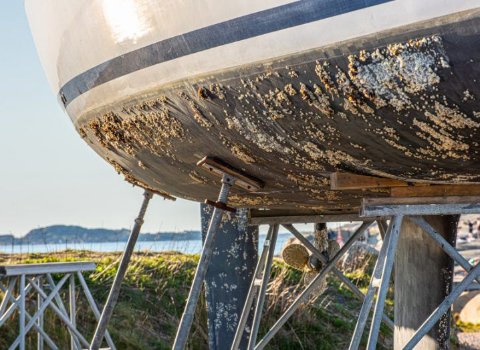Researchers at DCU have developed a material to protect against a sticky underwater problem.
You’ve heard of dog fouling, but have you heard of biofouling? This is the term for the accumulation of microorganisms, plants, algae and small animals on the surfaces of underwater structures, such as ships’ hulls, piping or grates. Though not as annoying as dog fouling when you’re out for a walk, biofouling is a significant issue because it damages the structure and functioning of the objects and devices it clings to. For example, it can slow down ships or disrupt ocean sensors and energy devices. It can also be costly and time-consuming to remove.
The above description of biofouling might call up an image of barnacles, soft corals and seaweed stuck to a ship’s hull, but this is not where the process begins.
Within minutes of immersion in water, microorganisms attach to the surface of an object and form a biofilm. This is referred to as microfouling. If this slimy texture is not dealt with, it can ultimately support larger organisms, such as barnacles or mussels, in a stage known as macrofouling.
A research team at Dublin City University (DCU) have set their minds to solving this sticky problem. They have developed a material, inspired by fish, that significantly reduces biofouling. Their aim is to create a product that can applied to large surfaces to protect boats, ocean energy blades, buoys and other objects.
Led by Prof Fiona Regan from DCU’s Water Institute, the research team developed an understanding of how biofouling happens and identified a solution for reducing its impact. They developed a coating design which was inspired by brill, a flatfish that is found throughout European waters. The brill’s scales have micro spacings that prevent normal biofilm development, which the researchers say, can be easily replicated.
“Bioinspired surfaces, due to their nano and micro topographical features, offer a promising approach for the development of novel antifouling solutions,” the team wrote in their recently published paper in Science of the Total Environment.
In their laboratory testing, the team found that all micro-textured surfaces they tested exhibited a significant decrease in biofilm formation compared to control samples.
“Our work has discovered that these brill-inspired micro textures cause a disruption to the formation of a biofilm leading to surfaces that are easier to clean or have a slower rate of biofilm formation,” said Regan.
“We would hope to investigate being able to generate these textures at scale for application to large surfaces.”
Rebecca Graham
This article originally appeared on www.siliconrepublic.com and can be found here
You’ve heard of dog fouling, but have you heard of biofouling? This is the term for the accumulation of microorganisms, plants, algae and small animals on the surfaces of underwater structures, such as ships’ hulls, piping or grates. Though not as annoying as dog fouling when you’re out for a walk, biofouling is a significant issue because it damages the structure and functioning of the objects and devices it clings to. For example, it can slow down ships or disrupt ocean sensors and energy devices. It can also be costly and time-consuming to remove.
The above description of biofouling might call up an image of barnacles, soft corals and seaweed stuck to a ship’s hull, but this is not where the process begins.
Within minutes of immersion in water, microorganisms attach to the surface of an object and form a biofilm. This is referred to as microfouling. If this slimy texture is not dealt with, it can ultimately support larger organisms, such as barnacles or mussels, in a stage known as macrofouling.
A research team at Dublin City University (DCU) have set their minds to solving this sticky problem. They have developed a material, inspired by fish, that significantly reduces biofouling. Their aim is to create a product that can applied to large surfaces to protect boats, ocean energy blades, buoys and other objects.
Led by Prof Fiona Regan from DCU’s Water Institute, the research team developed an understanding of how biofouling happens and identified a solution for reducing its impact. They developed a coating design which was inspired by brill, a flatfish that is found throughout European waters. The brill’s scales have micro spacings that prevent normal biofilm development, which the researchers say, can be easily replicated.
“Bioinspired surfaces, due to their nano and micro topographical features, offer a promising approach for the development of novel antifouling solutions,” the team wrote in their recently published paper in Science of the Total Environment.
In their laboratory testing, the team found that all micro-textured surfaces they tested exhibited a significant decrease in biofilm formation compared to control samples.
“Our work has discovered that these brill-inspired micro textures cause a disruption to the formation of a biofilm leading to surfaces that are easier to clean or have a slower rate of biofilm formation,” said Regan.
“We would hope to investigate being able to generate these textures at scale for application to large surfaces.”
Rebecca Graham
This article originally appeared on www.siliconrepublic.com and can be found here
